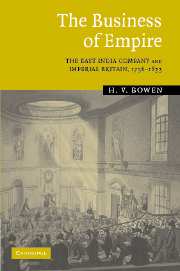Book contents
- Frontmatter
- Contents
- List of figures
- List of tables
- Preface
- Notes on the text
- List of abbreviations and short titles
- 1 Introduction
- 2 Relationships: city, state, and empire
- 3 Relationships: government and the Company
- 4 People: investors in empire
- 5 People: Company men
- 6 Methods: an empire in writing
- 7 Methods: the government of empire
- 8 Methods: the management of trade
- 9 Influences: the Company and the British economy
- Afterword
- Index
7 - Methods: the government of empire
Published online by Cambridge University Press: 09 July 2009
- Frontmatter
- Contents
- List of figures
- List of tables
- Preface
- Notes on the text
- List of abbreviations and short titles
- 1 Introduction
- 2 Relationships: city, state, and empire
- 3 Relationships: government and the Company
- 4 People: investors in empire
- 5 People: Company men
- 6 Methods: an empire in writing
- 7 Methods: the government of empire
- 8 Methods: the management of trade
- 9 Influences: the Company and the British economy
- Afterword
- Index
Summary
By the beginning of the nineteenth century the collection and organisation of information had brought a much-admired sense of order and purpose to the domestic affairs of the East India Company, but the Company was also acquiring a reputation for general administrative sophistication and excellence. Friends of the Company praised the hard work and dedication of the directors and home servants, and the management of East Indian affairs suggested to some that the Company should serve as a model for other British institutions. This began to convince onlookers that the Company was able to govern its empire not only in the interests of Britain, but also to the benefit of the Indian population. As a result, in 1813 Lord Castlereagh was able to use words that could scarcely have been whispered forty years earlier when he described the Company's Indian government as ‘founded on theory so wise, and brought to such practical perfection, that he did not believe the history of the world could exhibit its equal’. Nothing, he thought, ‘could be more ably and more efficiently managed than the affairs of the East India House’.
Castlereagh might well have been motivated by a desire to flatter the directors in return for political concessions, but his public declaration of faith in the Company was broadly representative of a remarkable transformation that occurred in attitudes towards the administration of East Indian affairs during the half-century or so after 1756.
- Type
- Chapter
- Information
- The Business of EmpireThe East India Company and Imperial Britain, 1756–1833, pp. 182 - 218Publisher: Cambridge University PressPrint publication year: 2005

